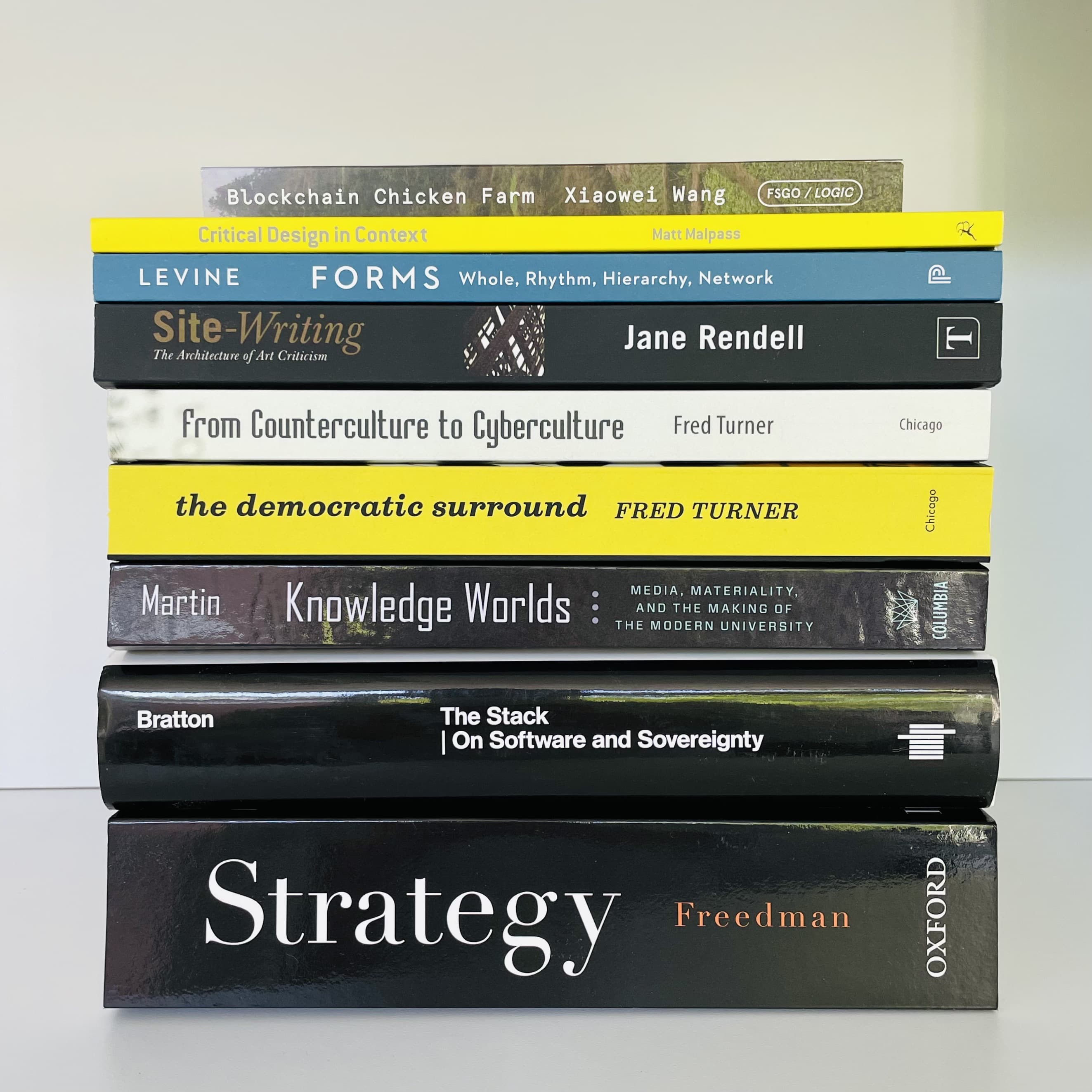Summer Reading
Last week, I posted the above photo on Instagram. It’s a stack of books I’m hoping to spend some time with this summer. Broadly, this collection displays much of my current research interests:
Media Studies
I’m increasingly interested in media theory, especially as it relates to graphic design and design history. Fred Turner’s two books, The Democratic Surround and From Counterculture to Cyberculture have been on my list for years, bridging interests I have in technology, media, and architecture.
Reinhold Martin’s new book Knowledge Worlds, is, perhaps, the book I’m most looking forward to reading this summer. Martin, an architectural historian, explores the infrastructural and ideological histories of higher education. I watched a talk he gave a Princeton a few months ago and found so many parallels to things I think about. I’m excited to dig in.
Writing and Criticism
Continuing my on-going research on design writing and criticism, I’m looking forward to reading Caroline Levine’s Forms, which was recommended to me on Scratching the Surface a few years ago and I’ve been remiss in actually reading. I watched a talk by Cynthia Davidson, founder and editor of Any and Log a few months ago and she quoted from Jane Rendell’s Site-Writing: The Architecture of Art Criticism. I don’t know much about the book but it seems right up my ally.
On the other end, Matt Malpass’s Critical Design in Context will supplement my research on the other side of criticism, not through writing but through the act of design itself. I’ve been wanting to write about critical design in a graphic design context for a while now and it’s something I’m hoping to spend time thinking about this summer.
Technology
Benjamin Bratton’s book The Stack had a moment a few years ago and I was really interested in it (and him) but wasn’t ready to commit to a 700+ page book. He’s a dream guest for me for Scratching the Surface so I’m hoping to spend some time within his ideas and (hopefully) get him on the show in the Fall. Xiaowei Wang’s essay collection, Blockchain Chicken Farm, has been recommended to me more time than I can remember at this point. I started reading this one this week and I understand why: it’s beautiful writing about big ideas in emerging technology, all through the lens of China’s countryside.
Strategy
The last one, and the biggest of the batch, is Lawrence Freedman’s epic history of strategy. I’ll read this one slowly, off and on in between the others. I’m tackling this one for two reasons. One, as someone interested in administration and the mechanics of bureaucracy (see Knowledge Worlds above), I’m hoping this can put some of that work in different contexts for me. Secondly, and perhaps more importantly, I’ve been thinking a lot about the overlap of design and strategy. Both of them, at times, define themselves as a type of planning. What can designers learn from strategists? Are designers strategists? Should designers learn strategy?1 As a new full-time faculty member, I think there are questions here to shape curriculums for design programs, graphic and otherwise.
Calling these the summer stack is optimistic, idealistic, and likely not realistic. I’m sharing these not because I expect to read them all in the next few months but rather as a marker of where my head is at this current moment. My reading for research (ie. for work, for projects, etc) is more sporadic, jumping in and out of books as opposed to reading cover to cover. It’s a method encouraged by my graduate professors and one I’ve passed on to my own students. Some of these, though, I do hope to really spend time with and read all the way through (Knowledge Worlds and Forms, especially.)
My reading for pleasure, on the other hand, is slower and more focused. Reading outside of work is focused mostly on fiction. I’m currently in the middle of Jay Caspian Kang’s 2012 novel, The Dead Do Not Improve which mixes crime, mystery, and cultural commentary into a narrative I can’t seem to put down right now. Before this was Noah Hawley’s (of Fargo and Legion fame) latest novel Anthem, which started strong but was probably one hundred pages too long. My two favorite books of the last few months were John Darnielle’s new novel, Devil House and Sheila Heti’s Motherhood.
I think Devil House is Darnielle’s best: he moves between voices and times, mixes genres and styles, all while offering original commentary on true-crime entertainment. It’s great. I’d never read Heti before but I adored Motherhood, fitting into my (very basic) interest in auto-fiction, stories about writers, and stories about parenting. New new book, Pure Colour, is next on my list!
On the comics side, after years of hearing about it, I’m finally starting Saga. More on that soon. I’m excited.
-
Obviously I’m not the first to ask these questions: I interviewed a series of folks on Scratching the Surface about strategic design. ↩
